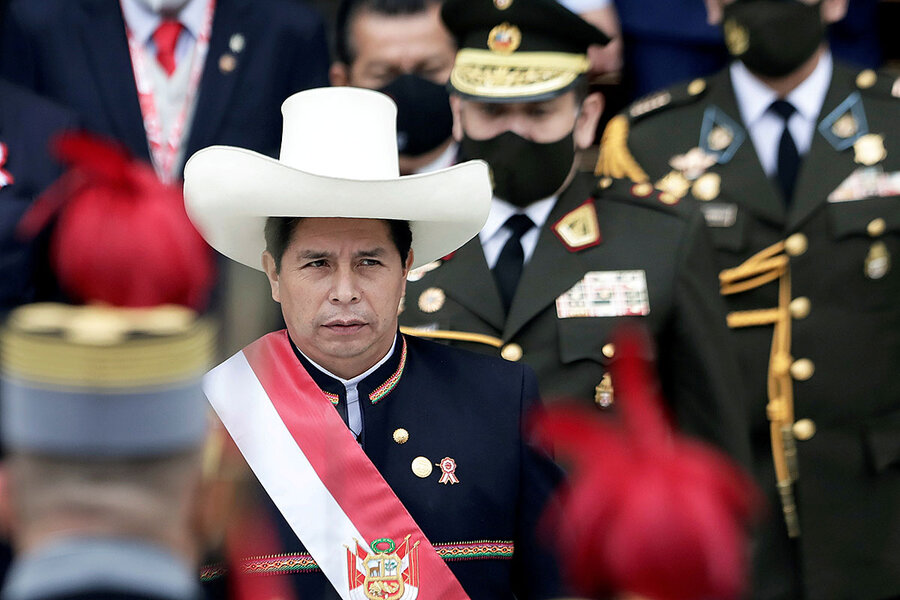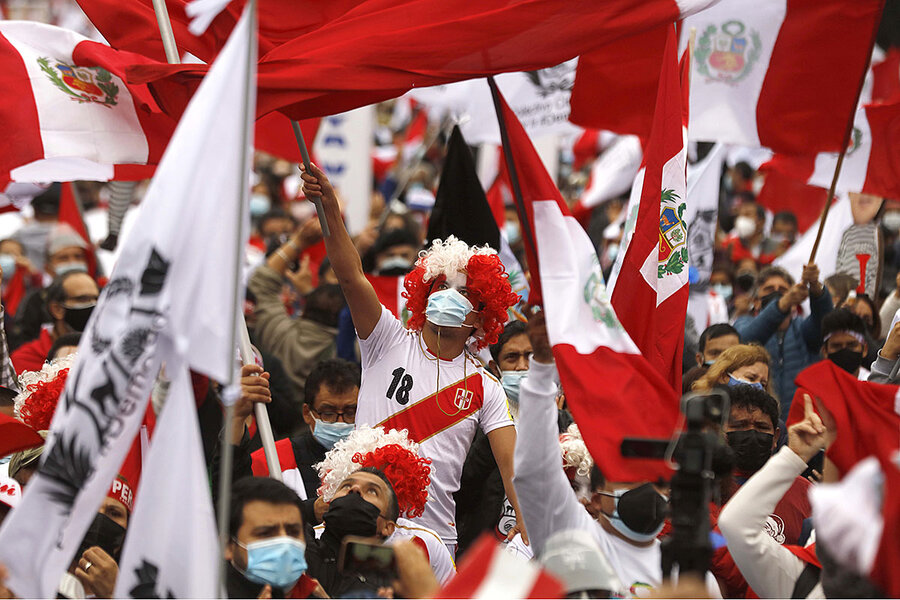Peru elected a leftist outsider as president. Now it asks, can he do the job?
Loading...
| Lima, Peru
Peru’s newest president, Pedro Castillo, taught in a remote village school for most of his adult life. In 2017, he rose to national prominence after launching a local strike to demand better working conditions, only to retreat back to his classroom and potato crops.
Three years later, cascading political crises led to three presidents in the span of one week and set the stage for this year’s election that Mr. Castillo narrowly won. He took office last week after a hard-fought election; his opponent, Keiko Fujimori, cried fraud, but her challenges to the results were rejected. Still, the legal disputes permitted Mr. Castillo just nine days to organize a transition from the previous administration.
Why We Wrote This
Peru’s presidential elections were meant to serve as a release valve for a country fed up with corruption and political crises. But in his first week in office, President Castillo has alienated allies and opponents.
He had instilled hope in many Peruvians because of his status as an outsider, far removed from the political machinery and corruption that have long tainted politics. But he has already exacerbated tensions by naming a Cabinet based more on party affiliations than on experience, which is likely to set the stage for more political drama.
“The president has chosen a Cabinet without experience at a time when Peru needs capable administrators,” says Julio Guzmán, a past presidential candidate of a centrist party.
Peru may have a new president, but the challenges he and his country face are decades old.
A rural schoolteacher and union leader, Pedro Castillo was inaugurated July 28 in a rushed transition after weeks of legal and political uncertainty. He’s not the first outsider to win the presidency in Peru, but he’s the only one to make the leap from the largely impoverished countryside to the country’s highest office.
Mr. Castillo, a candidate of the left, took office after a hard-fought election that he won in early June by 44,200 votes out of nearly 19 million cast. His opponent, Keiko Fujimori, cried fraud, but her challenges were rejected. Still, the legal disputes meant that Mr. Castillo had just nine days to organize a transition from the previous administration.
Why We Wrote This
Peru’s presidential elections were meant to serve as a release valve for a country fed up with corruption and political crises. But in his first week in office, President Castillo has alienated allies and opponents.
His victory was divisive but offered hope for many – especially in poor, rural areas. Peru has had five presidents since 2018, when Congress and the president began a game of political chicken: Presidents threatened to shutter the legislature and lawmakers snapped back, threatening to impeach presidents. Peru’s Constitution makes both relatively simple.
Many Peruvians held out hope that as a political newcomer, Mr. Castillo might break this pattern of compounding crises. Instead, he seems to only have exacerbated tensions by naming a Cabinet based more on party ideology than on experience, which has reshaped relations with his political allies and opponents, setting the stage for more political drama.
“The president has chosen a Cabinet without experience at a time when Peru needs capable administrators,” says Julio Guzmán, a past presidential candidate of a small centrist party.
From rural classrooms to the national stage
Mr. Castillo taught in a small school in a hamlet in northern Peru most of his adult life. His first breakthrough came in 2017, when he and other rural teachers called a strike to demand better conditions and salaries for educators working in far-flung areas who had to also work as cooks and janitors at their schools. The rural teachers broke with the national teachers union and slowly gained public and opposition support. The strike eventually led to a full-blown political crisis: Congress used the strike as pretext to force a major Cabinet shakeup.
The future president then retreated from the national stage to teach and tend his potato crops. Running for president was not even a consideration until a year ago, when the small Perú Libre party approached him to run. He did not join the party until last October, and he had little name recognition in early polls ahead of the first round of voting in April.
His success in the presidential election came down to a combination of factors. These included the pandemic, which exposed glaring inequities in Peru, including rising levels of hunger, and massive corruption among the political elite. One former president is in prison, two are under house arrest, and one may go on trial later this year for corruption. Peruvians, fed up with politics as usual, opted for the outsider who didn’t have ties to established parties and, crucially, wasn’t associated with corruption. Mr. Castillo won overwhelmingly in rural regions where Perú Libre is popular, coming close to 90% of the vote in some areas.
Cabinet controversy
While Peruvians hoped for a break from political gridlock, Mr. Castillo, in his first week in office, may have only worsened it. The trouble began with Congressman Guido Bellido, also a political newcomer, whom the president tapped to lead his 19-member Cabinet as prime minister. Mr. Bellido, who was elected to Congress in April, drew criticism after he praised a former combatant of the outlawed Shining Path insurgency.
As a result, Mr. Bellido faces anti-terrorism charges that carry a sentence of up to 20 years in prison. He’s not allowed to sit on the defense or intelligence committees in Congress while the investigation is underway, though he is still the head of the president’s Cabinet, giving him access to sensitive information.
And he’s just one of the ministers the opposition wants out. A far-right party has demanded another five ministers be removed from the Cabinet for alleged terrorism sympathies. One is Héctor Béjar, Mr. Castillo’s foreign minister, who trained in Cuba in the 1960s and was part of a small band of guerrillas that tried to spark revolution in Peru.
The other eight opposition parties in Congress have all demanded changes as well. Of the 19 ministers, 12 have raised objections from one or more party.
The Castillo government “has chosen ideology over pragmatism,” says Gonzalo Banda, a political science professor at the Catholic University of Santa María.
Part of the criticism of the Cabinet is ideological, but a number of ministers lack basic experience: Several have little or no firsthand knowledge in the sector they were chosen to lead. In the case of the transportation ministry, which manages the government’s largest investment budget, the selected minister is a former public school principal.
A missed opportunity?
Mr. Castillo was voted into office in an election that was meant to be a release valve from the protests and tensions that swept the nation in 2020, when Peru had three presidents in the span of a week at the height of the pandemic. But many worry his presidency may already be doomed as talk in Congress has turned to options like impeachment.
Mr. Castillo has not spoken publicly to address the criticism around his Cabinet picks. But he’s not helping himself by keeping quiet, says Jo-Marie Burt, an associate professor and Peru expert at George Mason University.
“Castillo’s silence on policy matters and the general orientation of his government is disconcerting. Peruvians want to know where the country is heading,” she says.
Mr. Guzmán fears Peru is facing yet another political crisis just as it emerges from its worst recession in three decades. While Peru has the world’s highest per capita COVID-19 death rate, according to Johns Hopkins University’s tracker, it is moving quickly with vaccines. Political gridlock could undermine much-needed progress on the pandemic and economic recovery.
“Politics and macroeconomic stability have been on parallel tracks, but not any longer. They are starting to collide,” says Mr. Guzmán.
The president, in an Aug. 5 ceremony with military and police brass, sounded a conciliatory note, saying he would govern for all Peruvians.
“In my government, we will crisscross all corners of the country to listen and work with all levels of government to meet the most urgent needs of our population,” he said. “We are going to govern with and for the people.”








